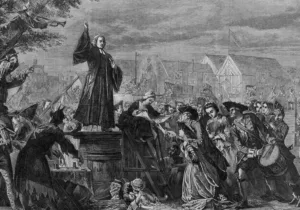On Labor Day, 1980, former California Governor Ronald Reagan campaigned before a cheering crowd along New York Harbor in full view of the Statue of Liberty, promising a new administration to renew the American dream, “and make America great again.” Thirty-six years later, a presumably attentive New Yorker Donald J. Trump would employ the same phrase in the same circumstance to capture the same Republican Party. Yet according to Gary Gerstle’s The Rise and Fall of the Neoliberal Order: America and the World in the Free Market Era (2022), the latter’s conscious intent and sole achievement was to sabotage the very principles of deregulation and globalization the former personified.
Professor of American History at the University of Cambridge, Gerstle revisits much of the reasoning introduced in his previous Rise and Fall of the New Deal Order (with Steven Fraser, 1989) in pursuit of a thick description of “the fall—or at least the fracturing—of a political order that took shape in the 1970s and 1980s and achieved dominance in the 1990s and first decade of the twenty-first century. I call this political formation a neoliberal order” (1). Representing an ironic but effective fusion of the neo-Victorianism of Speaker Gingrich and of the cosmopolitanism of President Clinton, it succeeded what Gerstle describes as the New Deal political order (1930s-70s) finalized by President Eisenhower’s acquiescence, but then gradually tainted by racial hostility, discredited by economic stagnation, and missed in action in the jungles of Vietnam.
Tracing with unusual finesse numerous correlations, intersections, and correspondences between diverse intellectual and ideological trends, Gerstle first demonstrates how the initially marginal ideas of libertarian political economists including Friedrich Hayek, Ludwig von Mises, and Ayn Rand had acquired enhanced financial resources and institutional representation by the 1970s, which in turn enabled their bipartisan politicization from the Reagan to George W. Bush administrations, inclusive, with the latter accurately characterized as an unwitting, semi-utopian and crusading idealist. The prestige of this resulting neoliberal political order was furthermore enhanced by the almost sacramental significance surrounding the unexpected implosion of Soviet Communism in 1989, wherein the totality of neoliberal principle in contravention of the Leninist central planning of production, distribution, and exchange temporarily appeared completely vindicated. The ultimate political consequences of 9/11, the Great Recession, and the fierce criticisms of both Senator Sanders (I-VT) and President Trump have nevertheless brought about the “break-up” (289) of a political order not irrationally held responsible by far too many for the disappearance of their livelihoods, the endangerment of their liberties, and the obstruction of their happiness.
On its own terms, Professor Gerstle’s thesis is fundamentally correct. The especially international economic program of Presidents Reagan and Clinton consisting of the institutionalization of the free movement of goods, services, capital, and people, and concomitant removal from consideration of tariffs, import quotas, protection for infant or nationalization of private industries, or any other form of protection has been deeply discredited, both functionally and normatively. The author is also to be commended for his sincere intention and rare capability to immerse himself in the mind of frequently vilified Republican presidents and their supporters, in compliance with the principle of E.H. Carr in What is History? (1961) that the subject “cannot be written unless the historian can achieve some kind of contact with the mind of those about whom he is writing” (27). Gerstle’s probing synthesis is therefore likely to inform attentive readers adhering to a broad range of political opinions.
His account nonetheless demonstrates at least one analytical and one empirical defect. First, insufficient conceptual development surrounds the crucial use of the term political order, described in one place as consisting of “the ability of a partisan movement to define the parameters of American politics in enduring ways” (20), and in another as apparent “when the opposition acquiesces to an order’s ideological and policy imperatives” (156). The former quotation employs the word political in its own definition, and the latter amounts to the statement that order exists where present. Gerstle appears to mostly be describing the violent disruption of a neoliberal ideological consensus; but the point is not purely semantic. His most serious accusation against the formerly hegemonic neoliberal political order is that it deliberately introduced a policy of African-American imprisonment on account of that subgroup’s perceived lack of productivity. “With this [minority] population removed from the economy…neoliberals could get on with the business of building a successful market economy” (132). But Gerstle contradicts this monstrous assertion in the conclusion, wherein he summarizes, “A neoliberal order prizing global free markets and free movement of people…ignored the problem of mass incarceration” (290). However distressing its expense, volume, and spectacle of human bondage, non-white imprisonment in the United States cannot simultaneously be presented as the bitter fruit of a dastardly conspiracy near the outset, and as the unwanted distraction from a complex interdependence near the completion of the so-called neoliberal order.
The other main potential objection is evidentiary. Gerstle in his account of especially the construction of neoliberal order largely fails to consider the immediate and unqualified institutionalization of globalist principles at the international level after World War II, proper appreciation of which appears to endanger his chronology. “It is hereby declared to be the policy of the United States,” reads the Bretton Woods Agreements Act of 31 July 1945, “to seek to bring about further agreement and cooperation among nations and international bodies, as soon as possible, on ways and means which will best reduce obstacles to and restrictions upon international trade” (14). “Any advantage, favour, privilege, or immunity granted by any contracting party to any product originating in or destined for any other country,” continues the transformative most favoured nation provision of the General Agreement on Tariffs and Trade ([1986] 1948), “shall be accorded immediately and unconditionally to the like product originating in or destined for the territories of all other contracting parties” (1.1). “The Parties,” adds the North Atlantic Treaty, revealingly, the following year, “will seek to eliminate conflict in their international economic policies and will encourage economic collaboration between any or all of them” (2). Such quintessential neoliberal treaty terms, it must be emphasized, constitute not merely political ideology, but federal law, and cannot without embarrassment be inserted into a timeline wherein, “the collapse of communism…was the moment when neoliberalism in the United States went from being a political movement to a political order” (149). But per the celebrated findings of the most highly distinguished Austrian school identified above, order, after all, is held to be spontaneous.






 Sponsor a student for Christianity & National Security 2024
Sponsor a student for Christianity & National Security 2024